Market Trends of United States Optoelectronics Industry
The Image Sensors Segment Anticipated to Drive Demand
- Image sensors are a crucial component in optoelectronics that allows cameras and imaging devices to convert photons into electrical signals that can be interpreted and processed. The first digital cameras used charge-coupled devices (CCDs) to facilitate the movement of electrical charge through the device for modulation. However, modern cameras predominantly use complementary metal-oxide-semiconductor (CMOS) sensors due to their low power consumption, high integration, and compatibility with standard CMOS fabrication processes.
- With the upsurge in the demand for high-definition image-capturing devices in various industries, CMOS technology has experienced a high adoption rate. CMOS technology provides a faster shutter speed while delivering high-quality images. Moreover, advancements in artificial intelligence (AI) and machine learning have enabled smarter image-processing algorithms. These algorithms enhance image quality and enable features such as facial recognition, object detection, and augmented reality (AR), creating new opportunities for image sensors in various.
- The proliferation of smartphones and consumer electronics is a significant driver of the image sensor market in the United States. Smartphones have become ubiquitous, and the demand for high-quality cameras in these devices has surged. With consumers increasingly relying on their smartphones for photography and videography, manufacturers are continually upgrading camera systems to include advanced image sensors.
- Additionally, the rise of social media platforms, where visual content is extremely important, has heightened consumer expectations for camera performance. This trend has led to increased investment in high-resolution image sensors with features such as optical zoom, low-light performance, and image stabilization.
- The automotive industry's shift towards advanced driver-assistance systems (ADAS) and autonomous vehicles is another critical driver of the image sensor market. Image sensors play a vital role in enhancing vehicle safety and functionality through applications such as rearview cameras, lane departure warnings, and parking assistance systems.
- As automakers incorporate more sophisticated sensor technologies to support features like 360-degree visibility and pedestrian detection, the demand for high-performance image sensors is expected to grow. The ongoing development of fully autonomous vehicles will further accelerate this trend, creating new opportunities for image sensor manufacturers.
- The United States is one of the largest automotive markets in the world. Being home to prominent automotive industry leaders, such as General Motors, Ford, and Chryslers, vehicle production in North America is growing significantly. With the increasing usage of cars in the United States, the demand for smart parking is also growing, propelling the demand for compact camera modules for application in parking surround view. According to BEA, at just under 1.07 million unit sales, light trucks remained the most significant US auto market segment in May 2023, down from over 1.07 unit sales in April 2023 and increasing by approximately 23.06% year-on-year.

The Information Technology Sector to Hold a Major Market Share
- One of the primary applications of optoelectronics is in fiber-optic communication. Fiber-optic cables transmit data as light pulses generated by lasers or light-emitting diodes (LEDs). This technology allows for much higher bandwidth than traditional copper cables, enabling faster internet speeds and greater data capacity. Fiber optics are essential for backbone networks, connecting cities and countries, and for last-mile connections to homes and businesses.
- Optoelectronic components, such as photodetectors and optical amplifiers, are also vital in communications systems. Photodetectors convert incoming light signals back into electrical signals, while optical amplifiers boost the strength of these signals over long distances, ensuring minimal loss of data integrity. Technologies like wavelength-division multiplexing (WDM) utilize optoelectronic principles to send multiple data streams simultaneously over a single fiber, significantly increasing network efficiency.
- Additionally, the demand for compact and energy-efficient optical transceivers has been on the rise in recent years. This increase in demand can be attributed to several factors, including the growing installation of optical transceivers for data center aggregation and backplane applications, as well as the need for high-speed data transmission. Such trends are anticipated to offer lucrative opportunities for the growth of the market.
- In addition to communication, optoelectronics is crucial in data centers, where it supports high-speed data processing and storage systems. Laser-based interconnects and optical switches enhance the speed and efficiency of data transfer within and between servers, improving overall performance and reducing energy consumption.
- As data demands increase, the transition to optical interconnects becomes more common, offering a scalable solution for future growth. According to Cloudscene, as of March 2024, there were a reported 5,381 data centers in the United States, the most of any country worldwide. The robust data center ecosystem in the United States is likely to significantly drive the growth of the studied market.
- Moreover, optoelectronics is integral to emerging technologies like the Internet of Things and 5G networks. In IoT, optoelectronic sensors and devices facilitate real-time data collection and transmission, enhancing connectivity and automation in a diverse range of applications, like from smart homes, industrial systems, etc. For 5G, optoelectronic components enable higher frequencies and faster data rates, supporting the growing need for mobile connectivity in the United States.


